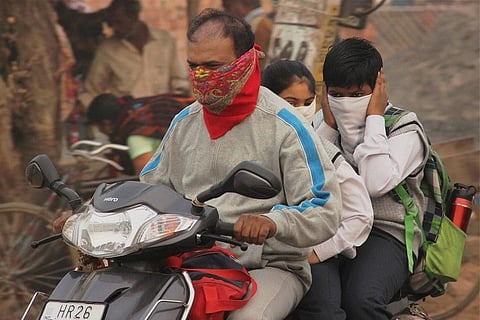

After several days, the thick smog enveloping Delhi seems to have dissipated, temporarily at least. But not before Chief Minister Arvind Kejriwal on Saturday mandated for schools to be shut and all construction projects to be halted in the city for the next five days. These announcements, among others, were a response to the growing hue and cry around Delhi’s alarming pollution levels, which peaked following Deepavali.
But it’s not just Delhi which is struggling under a massive pollution problem. Many other cities in north India seem to be in a similar crisis. According to a Hindustan Times report by Chetan Chauhan, Central Pollution Control Board (CPCB) data shows that the increase in particulate matter in Indian cities is higher than that in metropolitan cities world over.
The numbers in the image show the Air Quality Index (AQI). These numbers can be broken down into PM2.5 and PM10, where ‘PM’ stands for particulate matter, while the accompanying numbers give the size of these particles, measured in microns.
PM2.5 matter is made up dust and pollen but also particles from burning coal, from gasoline cars and other pollutants. These particles are small enough to enter our bloodstream and result in many respiratory illnesses as well as problems in the circulatory system.
PM10 matter include PM2.5 and are also known as "respirable suspended particulates". These too are associated with a wide range of respiratory and cardiovascular health risks when inhaled. These include inflammation of airways resulting in coughing and wheezing, asthma attacks, chronic bronchitis, high blood pressure and stroke to name a few.
CPCB’s analysis was based on over a decade worth of data – from 2002 to 2014. Apart from major cities in the north, Gwalior and Kanpur in central India have also seen a higher jump in pollution levels between 2002 and 2014, when compared to Delhi. In 2013, a WHO report named Ludhiana India’s most polluted city. And in 2015, 10,000 vehicles were added to its roads per month, on an average.
Agra another city close to Delhi and the NCR, isn’t faring much better either, with Shahganj’s Air Quality Index (AQI) hitting dangerous levels at 677.
Following Deepavali on October 30, Agra’s AQI was 384, while the limit for good air is 100. Faridabad and Delhi had AQI of 428 and 425 each, according to a report in The Hindu.
Alison Saldanha and Karthik Madhavapeddi’s analysis based on Breathe data in IndiaSpend compared data from CPCB and Breathe monitors in Lucknow, Agra, Varanasi and Patna from 2015 and 2016 during the Deepavali period. They observed:
“Patna recorded a 24-hour average PM 2.5 level of 437.3 µg/m³– nearly 95% higher than the levels recorded last year (224.9 µg/m³) and 17 times above WHO guideline levels. In Varanasi, while Diwali day itself recorded a 40% higher average of PM 2.5 at 247.1 µg/m³, the next day’s levels continued to soar to an average of 578.6 µg/m³, 23 times above WHO guideline levels. Agra recorded rising pollution levels progressively up to the morning of November 1, 2016, more than double the values recorded last year. Lucknow recorded a 37% increase in PM 2.5 levels in 2016 over 2015.”
According to Breathe numbers, Delhi now looks something like this:
And this is what AQI in Noida and Gurugram, rapidly industrialising cities in the NCR region, looks like:
Unsurprisingly, firecrackers were speculated to be behind the pollution which peaked after Deepavali. Swagata Yadavar’s report in IndiaSpend quotes a study which found that popular firecrackers like laadi (string of crackers), phooljhadi (sparkler) and anaar (flower pot), among others, emit particulate matter 200 to 2000 times above safe limits.
Later however, the practice of burning crop waste – about 32 million tons of leftover straw – in the neighbouring states of Punjab and Haryana was blamed for the smog that continues to choke Delhi. Kejriwal had said on Saturday that the pollution was being caused by “use of firewood, coal, diesel, petrol and burning of agricultural waste”.
While farmers in Punjab are aware of how the practice is costing the environment, they say they cannot afford the technology for alternative disposal methods, according to a New York Times report.
Despite the recent furore, it is difficult to point fingers at one source. While firecrackers did deliver a significant blow on the deteriorating air quality, vehicular emissions and smoke from stubble burning also account for a quarter each of the particulate matter emissions, according to a report by Kiran Stacey in Financial Times.